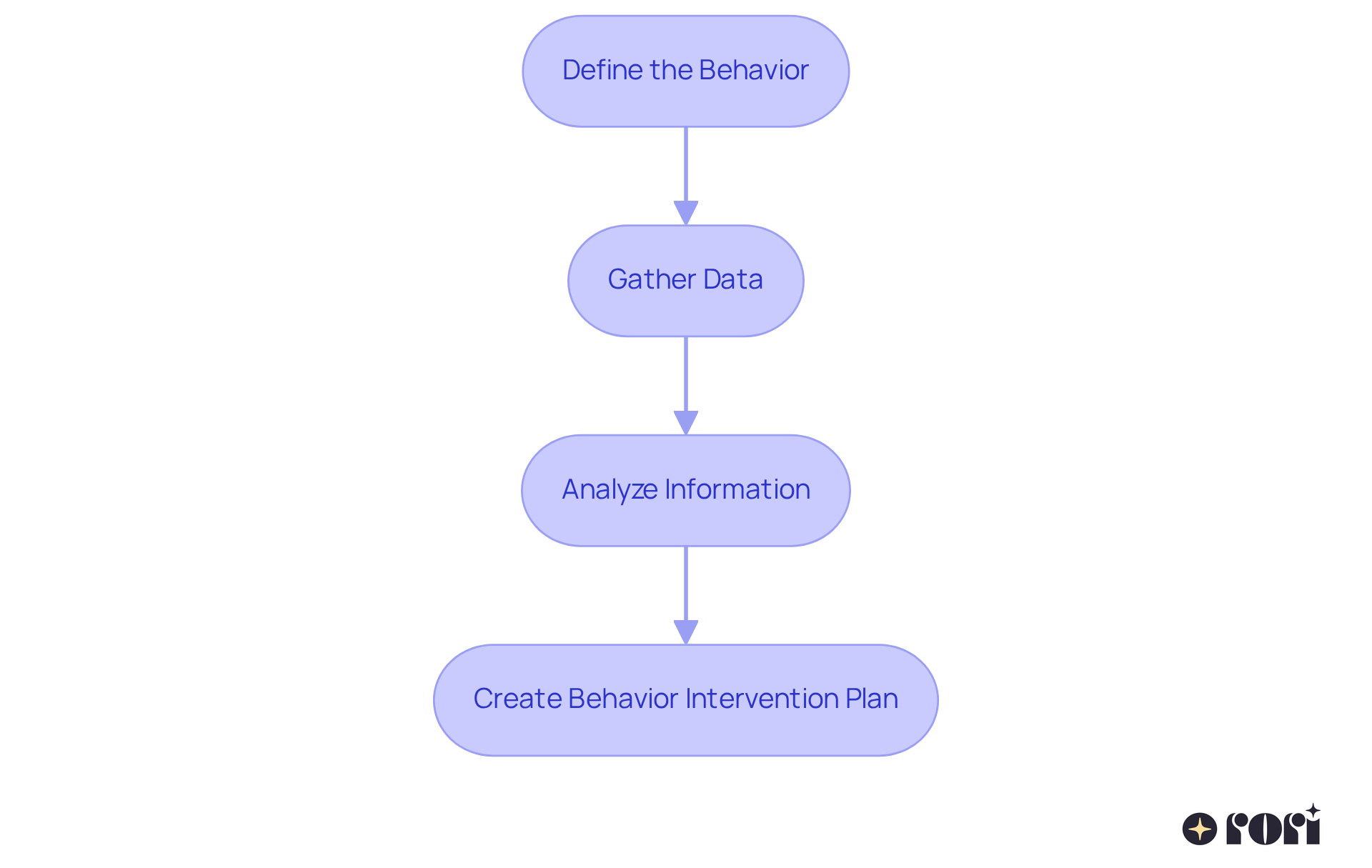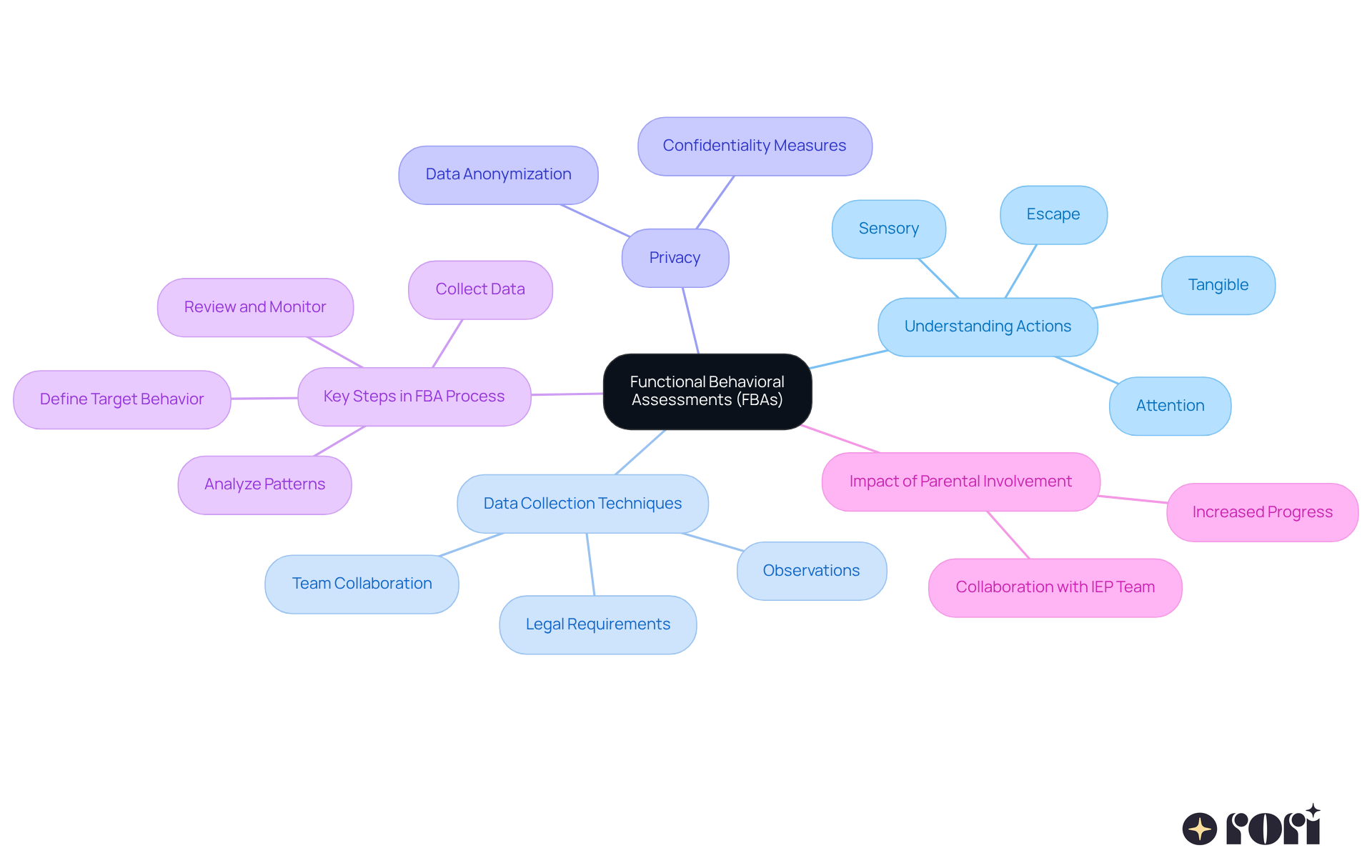Functional Behavior Assessments (FBAs) are all about understanding why our kids with autism might act out. They help us get to the heart of challenging behaviors, paving the way for tailored interventions that really make a difference. 🌟
So, how does it work? Well, the FBA process involves a few key steps:
This approach not only enhances the effectiveness of autism treatment but also ensures that strategies are individualized to fit each child’s unique needs.
Let’s explore this together! By understanding these processes, we can better support our children and help them thrive. Remember, you’re not alone on this journey; we’re here to help you every step of the way!
Understanding the complexities of autism treatment can feel overwhelming, can’t it? It often starts with exploring the methods that guide effective interventions. One of the standout tools in this journey is the Functional Behavior Assessment (FBA). These assessments are like a window into the motivations behind challenging behaviors, helping clinicians understand what drives a child’s actions.
Imagine a child acting out—maybe they’re seeking attention, trying to avoid a task, or fulfilling a sensory need. FBAs help uncover these reasons, paving the way for tailored strategies that not only address symptoms but also enhance the child’s overall quality of life.
But here’s the big question: how can we effectively implement these assessments to truly meet each child’s unique needs? Let’s explore this together! We’re here to help you every step of the way!
FBA's are systematic processes that help us understand the reasons behind challenging behaviors, especially in children with autism. The main goal of FBA's is to determine why a child might be acting out—whether they’re seeking attention, trying to avoid something, wanting a reward, or needing sensory input. By getting to the heart of these motivations, clinicians can develop targeted interventions that address the root causes instead of just managing the symptoms.
You might find FBAs popping up often in Applied Behavior Analysis (ABA) therapy, which is a flexible and patient-centered approach that’s shown real success in treating autism. In fact, this therapy uses learning principles to make significant progress in about 90% of children when the recommended hours are fully utilized with active caregiver involvement. FBA's are typically used at Tier 3 within multi-tiered systems of support (MTSS) for students facing serious behavioral challenges.
So, what does the FBA process look like? It usually involves four key steps:
With the help of advanced AI, Rori Care - ABA Therapy is making strides in improving the efficiency of ABA therapy by automating progress report creation, which frees up 50% more time for actual treatment.
This comprehensive approach not only helps us understand behaviors better but also supports the development of effective strategies that encourage positive changes and enhance the overall quality of life for children with autism. It’s also important to remember that schools are required to conduct FBA's, or functional behavior assessments, under the Individuals with Disabilities Education Act (IDEA) after a child has been away from school for a while. Typically, the process of an FBA's assessment takes about 1 to 4 weeks from the first observation to the completed BIP, and it’s crucial to have a multidisciplinary team—like Board Certified Behavior Analysts (BCBAs) and other professionals—working together to ensure the assessment is thorough and effective.
Let’s explore this together! If you have any questions or experiences to share, we’re here to help you every step of the way!

In autism therapy, FBA's are essential tools utilized by clinicians and analysts. They play a key role in evaluating and guiding personalized treatment plans. Think of an FBA as a systematic way to uncover the reasons behind challenging behaviors. This helps clinicians design tailored interventions that can really boost treatment effectiveness.
For example, if an FBA reveals that a child acts out to avoid a tough task, the intervention might focus on teaching coping strategies while gradually increasing the task's difficulty. This personalized approach not only improves outcomes but also empowers families by involving them in the decision-making process about their child's care.
Rori Care's conduct care engine enhances this process by performing functional behavior analysis for specific actions and skills. It even generates automatic progress reports for clinicians to review. This tech integration makes evaluations easier and provides caregivers with valuable insights, allowing them to actively participate in their child's behavioral goals through data collection.
Research shows that when parents are involved in the process of FBA's, the likelihood of successful interventions increases. Their insights contribute to a deeper understanding of their child's behavior. Ultimately, FBA's serve as the foundation for developing effective, individualized strategies that meet the unique needs of children with autism. This fosters a collaborative environment between families and professionals.
Let’s explore this together! We’re here to help you every step of the way!

FBA's have their roots in Applied Behavior Analysis (ABA), which started to take shape back in the mid-20th century. Initially, analysts focused on what they could see—observable actions and their direct consequences. But as our understanding of behavior grew, it became clear that we needed a more comprehensive approach. That’s where FBA's play a crucial role! They offer structured ways to evaluate actions, like direct observation and careful data gathering. This means practitioners can not only see specific behaviors but also understand the reasons behind them.
The journey of FBA's has been shaped by ongoing research and a growing recognition of the need for personalized, function-oriented interventions. Research shows that when FBA's are conducted effectively, they lead to tailored intervention strategies that significantly help kids with autism develop functional skills. For example, the ABC model—Antecedents, Behavior, and Consequences—has become a key tool in understanding behavior patterns, allowing for more precise interventions.
Looking back, the history of FBA's reveals just how crucial they are in shaping effective autism treatment. As the field has evolved, there’s been a stronger focus on individualized assessments, reflecting a deeper understanding of the complexities of autism. This evolution underscores the importance of conducting FBA's in crafting strategies that not only address challenging behaviors but also enhance overall treatment outcomes for individuals with autism. Plus, with the rise of AI-powered tools in ABA therapy, data gathering and progress report creation can be done automatically, freeing up 50% more time for treatment. This really boosts the efficiency of the therapeutic process!
Let’s explore this together! If you’re a parent navigating these waters, know that you’re not alone. We’re here to help you every step of the way!

FBA's are all about understanding the actions of young people with autism in a thoughtful way. They involve a structured approach to collecting data, which is made even easier with automatic techniques. This means clinicians can focus on the child without any interruptions! Plus, the data is kept safe, anonymized, and deleted after analysis to ensure confidentiality and integrity.
When we talk about behaviors, it’s important to recognize the triggers and outcomes in the context of FBA's. This helps us create hypotheses about why certain actions happen, which we can categorize into four main areas:
The key steps of the FBA's process include a few essential stages. First, we clearly define the target behavior in observable terms. Then, we collect data through direct observation and interviews, analyzing it to find patterns. This is a team effort! The IEP team, which includes educators, psychologists, and parents, works together to understand the unique behavioral profile of each child. And guess what? When caregivers are actively involved, about 90% of children show significant progress when the recommended hours are fully implemented.
It’s also crucial to regularly review and monitor interventions. This way, we can adapt strategies based on the data we gather over time. Remember, legal requirements under IDEA 2004 mean that parental consent is needed before conducting FBA's, ensuring that parents are part of the decision-making process. Tools like ABC data collection help track progress effectively. By looking at the frequency of specific triggers and consequences, practitioners can tailor interventions that address the root causes of challenging behaviors. This creates a more supportive environment for learning and social interaction.
This patient-centered and adaptable approach has proven effective for autism treatment. It highlights the importance of early intensive behavioral intervention (EIBI) in improving learning, verbal, and social skills in children. Let’s explore this together! We’re here to help you every step of the way!

Understanding Functional Behavior Assessments (FBAs) is so important for addressing the needs of children with autism. These assessments offer a structured way to uncover what drives challenging behaviors, helping clinicians create personalized interventions that really make a difference. By focusing on the root causes instead of just managing symptoms, FBAs play a key role in improving the quality of life for both children and their families.
This article walks you through the comprehensive process of FBAs. It involves:
Collaboration is crucial here! When parents and professionals come together, their combined insights lead to more effective interventions. Plus, with the integration of technology—like AI-powered tools—data collection and reporting become smoother, making the therapeutic process even more impactful.
Ultimately, we can’t underestimate the significance of FBAs in autism treatment. They help us understand individual behavioral patterns on a deeper level and empower families to take an active role in their child's care. As the field evolves, our commitment to personalized, function-oriented interventions remains essential. Engaging in the FBA process is a vital step toward fostering meaningful progress and supporting children with autism in reaching their full potential.
Let’s explore this together! We’re here to help you every step of the way!
What is a Functional Behavior Assessment (FBA)?
A Functional Behavior Assessment (FBA) is a systematic process used to understand the reasons behind challenging behaviors, particularly in children with autism. Its main goal is to identify the motivations behind a child's behavior, such as seeking attention, avoiding something, wanting a reward, or needing sensory input.
How are FBAs used in therapy?
FBAs are often utilized in Applied Behavior Analysis (ABA) therapy, which is a flexible and patient-centered approach that effectively treats autism. The insights gained from FBAs help clinicians develop targeted interventions that address the root causes of behaviors rather than just managing symptoms.
What are the key steps involved in the FBA process?
The FBA process typically involves four key steps: 1. Defining the behavior to address, 2. Gathering data through direct observation, interviews, and record reviews, 3. Analyzing the information to understand the function of the behavior, and 4. Creating a personalized Behavior Intervention Plan (BIP).
How long does the FBA assessment process take?
The FBA assessment process usually takes about 1 to 4 weeks, from the first observation to the completed Behavior Intervention Plan (BIP).
Who is involved in conducting an FBA?
A multidisciplinary team, which may include Board Certified Behavior Analysts (BCBAs) and other professionals, is essential for conducting a thorough and effective FBA.
Are schools required to conduct FBAs?
Yes, schools are required to conduct Functional Behavior Assessments under the Individuals with Disabilities Education Act (IDEA) after a child has been away from school for an extended period.
How does Rori Care - ABA Therapy enhance the FBA process?
Rori Care - ABA Therapy uses advanced AI to improve the efficiency of ABA therapy by automating the creation of progress reports, which allows for 50% more time to be dedicated to actual treatment.